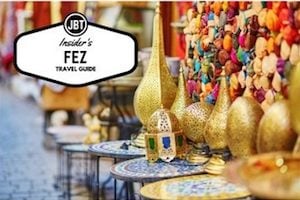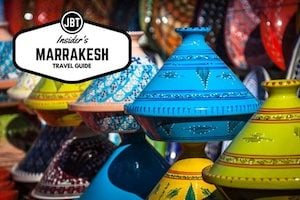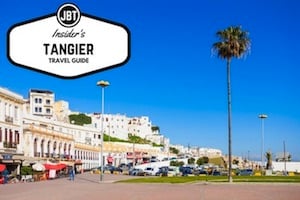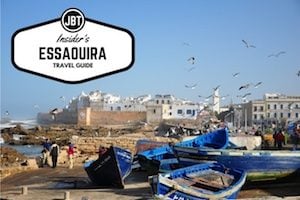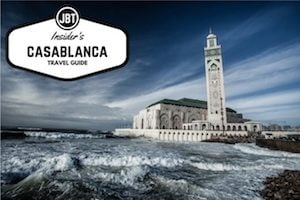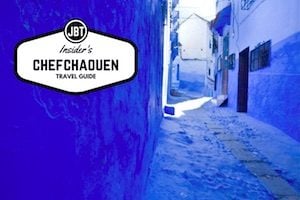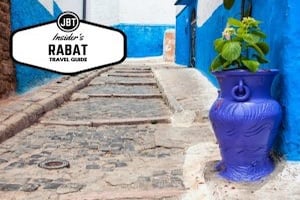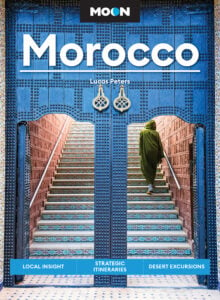
It’s barely turned to fall, but we can never have too much forward planning when it comes to spring break, the ultimate family vacation par excellence. I think Morocco is the perfect spring break destination. In no particular order, here are my top five reasons to take a family vacation to Morocco during spring break:
1. To replenish your Vitamin D reserves. While the sun still makes very sporadic appearances in Europe and much of the US, Morocco is graced with a steady supply Vitamin D-boosting, good-mood-stimulating rays starting from early March.
2. Because you must ride a camel at least once in your lifetime! See below for a full exposé.
3. Moroccan food is a top contender on the scene of international cuisine, along with Indian, Italian, Thai and the other heavy weights (no pun intended). From hearty tajines to delicately flavored bastilas, Morocco makes for splendid eating that is sure to please any foodie who enters.
4. Morocco is an incredibly photogenic country; I sometimes wish my eyes were cameras because there is so much rich visual input, and I am such a shy photographer.
5. If you or your parents (or grandparents) were old hippies then it’s time to ride the Marrakesh Express. (Unless that is code for something else… sorry my parents were vague about the meaning of the song!) Morocco has such lore attached to its name (as does the famed city of Marrakesh), it’s good to investigate for yourself and create your own references and memories.
Speaking of memories, one of my favorite spring break memories is the trip to the Sahara Desert that we took as a family a few years ago. We arranged for the two-year-old to stay with some family friends in Marrakesh (where we live) because we didn’t want to put him, or ourselves, through the 10-hour road trip. Aside from leaving the little guy behind, it was a true family adventure, spanning three generations: our two other children (ages four and seven) my in-laws, and us, the parents/children of the former/latter.
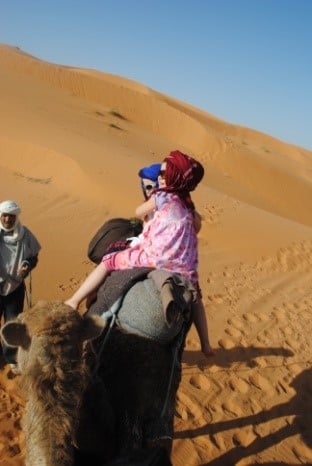 WHY DO CAMELS LIKE FLUTE MUSIC?
WHY DO CAMELS LIKE FLUTE MUSIC?
The drive is fairly windy for the first 3 hours or so, until Ouarzazate. The landscape changes quite rapidly. One first drives through lush and verdant valleys up into and over the Atlas mountains. We passed through valleys of ethereal almond trees in full blossom, whose white and rose petals disperse in snow-like flurry with the rustling of the breeze. Beyond the Tizi n Tichka pass, the terrain changes dramatically, turning rocky and arid, like a desolate lunar landscape. Although we equate desert with sand, most of the desert topography is comprised of the much less romantic badlands – expanses of rocky terrain in which neither man nor beast (nor desert flower) are especially suited to flourish.
The sand dunes of postcard fame were our desired destination, and to reach them we drove to the end of the road, literally (and I’m using the word correctly), in Merzouga, where our guide, Moha, met us with our next mode of transportation: camels. Even our 4-year-old got his own camel. 7-year-old daughter was a little scared of getting on the camel, it can be quit startling as it pitches way forward to stand up. Moha was very kind in helping her get on without too much pitching (and hopefully without a lifelong fear of camels). We set off with only our overnight bags, Moha leading the caravan on foot. I asked him why he walks, and he explained the his camels will only walk following him, they won’t follow anyone else. Another very wonderful thing I learned about camels is that they are happier when music is playing, specifically flute music. We were passed by a larger caravan that had a flute player. When the camels are happier, they walk faster. May we all find our own flute player.
WE ARE THERE YET
The camel ride was magical; we soon left the village behind and were riding in the middle of endless rolling sand dunes, and along with rhythm of the camels it felt like we were adrift in a vast ocean. As we’d gotten to Merzouga rather late, it was sunset time, and soon the moon became our only beacon. It was an experience of emptying out, the constant buzz of city life–muted, detoxing from sensorial pollution in all its forms: visual, auditory, olfactory… And it was the first time, as a family, we’d actually used an animal for transportation. The experience was a little scary, and also thrilling; it gave us all an amazing sense of accomplishment and a feeling of awe for those who do it every day. There is no experience quite like riding a camel alongside your own child, or your beloved, held by the quiet, full vastness of the desert. Familial conversation is elevated above the mundane exchanges of cohabitation and common interest, outside of the standard matrix of time and space. Who are we when we don’t have any business to take care of, any homework assignments due, any gas bottle to change, any strange car sounds to investigate…when those things seem as far away and miniscule as the stars in the vast desert sky.
As enamored as I was with the camel ride, I was ready for it to be over. The soul is elevated but the body…is taking an absolute thrashing from the very wide saddle and very bumpy camel’s gait. It was only the next day that I made this valuable observation: all the locals ride side-saddle.
SAND, SAND EVERYWHERE
Our encampment was a real honest-to-goodness oasis, a grove of palm trees fed by the water only five feet underground. It was set up with many large tents, ours even had beds and mattresses, and we were treated to a very much appreciated tajine cooked over charcoal. I love this Saharan definition of camping. We were out of cell-phone reception range, which is such a rare occurrence, like a planetary alignment or a lunar eclipse. We had one of the best nights of sleep (ever?), away from the vibrations of the city and civilization, even the dreamscape is clean, open, rich and mysterious. The next morning we woke the kids up early to catch the sunrise, and it was like watching the dawn of creation, a single point of light emerging from darkness and setting the endless sea of sand ablaze.
Then for a few hours the kids reinvented sand-surfing, by climbing up to the top of the highest sand dune and scooting down, and getting sand everywhere humanly possible (I was washing sand out of their hair and ears for a week). It was a new and uniquely liberating feeling as a parent to know that the little ones could go wherever they wanted, they could literally run in any direction for as long as their legs would carry them, with no worry of cars, bad guys, or hurting themselves because the sand is so soft and so fun, like being in a giant’s sandbox.
Speaking of sand everywhere, one very practical point to remember is that you don’t want sand in your camera or laptop. Bring the minimum amount of electronic toys, and think about Ziplock bags.
Ours was a short trip, we had to set back that afternoon. Time permitting, I would have loved for our family to have at least one full day and two nights in the desert.
SPRING BREAK FAMILY DESERT TRIP FACT SHEET
Best time of year to visit: September-November or February-May
Weather in springtime: Warm in the daytime, pleasantly cool at night. Bring both sun protection and jackets.
Best for ages: 4-75
Time frame: 4-5 nights
Trip itinerary:
Marrakesh – Ait Ben Haddou (or Skoura), 5 hour drive. Many travel over the mountains and spend the night in Ait Ben Haddou, a world heritage UNESCO site. It’s an ancient kasbah where scenes of movies such as Kundun, The Mummy and Babel were filmed. A more removed (and even surreal) location to spend the night is in Skoura – best arranged by the Morocco tour experts here at Journey Beyond Travel!
Ait-Ben Haddou – Merzouga, 5 hour drive. Stop in Kalaat M’Gouna, home of Moroccan rose water. Great for hiking and picnicking. Good for overnight for independent travelers.
Merzouga – Camp, 1.5 hour camel ride. Spend 1-3 nights. Try to avoid riding in midday especially when the heat is at it’s strongest from April through September.
Make it an educational experience for the kids by paying attention to certain points of interest:
A. Observe how houses are built, try to guess building materials: adobe (mix of earth and straw), vs. cement block. Advantages of one over the other. Nomadic tents made of woven wool, goat hide.
B. Pre-teach a few Arabic words: shokran (thank you), salam alaykom (peace be upon you/standard greeting), safi baraka (that’s enough/there is blessing in this amount), wakha (ok), lla (no), aah (yes), alhamdulilah (praise God/can be used as an answer to most questions), insha Allah (God willing).
C. Count as many modes of transportation as possible comparing animal powered with gasoline powered. Camel, donkey, mule cart, horse carriage, bicycle, motorbike, village bus. Which one would you want to ride?
D. Observe traditional dress, especially women’s clothes. See how it changes from one village to the next. Talk about tradition vs. modernity.
E. Observe how tajine is cooked: in a clay pot, over charcoal, eaten with only bread and fingers, no other utensils, from the same pot it is cooked in. However, beware also of “tajine fatigue”, as this is the main food that is available in most roadside places. Many days of eating tajine/bread can leave a person feeling heavy. Plan to bring some fruit and nuts along to balance it out.
Plan Your Spring Break Holiday
With so much to do in Morocco for all ages what are you waiting for? Start planning your getaway to Morocco during spring break today. Our amazing in-country staff is experienced with planning Morocco vacations for all age groups and can help ensure your family has an unforgettable experience. You can start exploring by learning more about tourism in Morocco, checking out our hand-made Morocco map, and even by taking a peek at our Wild Sahara or Ultimate Morocco itineraries.
About the Author
 Nora Fitzgerald likes to blog about her life in Morocco at moroccomama.wordpress.com where readers can “laugh, cry or roll your eyes.” She is founder of the Amal Women’s Training Center, a non-profit restaurant that aims to empower women from disadvantaged backgrounds. She lives with her husband and three children in Marrakesh, Morocco. Nora is a freelance writer, translator and development consultant.
Nora Fitzgerald likes to blog about her life in Morocco at moroccomama.wordpress.com where readers can “laugh, cry or roll your eyes.” She is founder of the Amal Women’s Training Center, a non-profit restaurant that aims to empower women from disadvantaged backgrounds. She lives with her husband and three children in Marrakesh, Morocco. Nora is a freelance writer, translator and development consultant.
